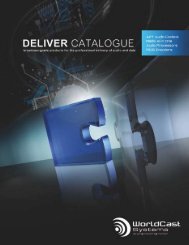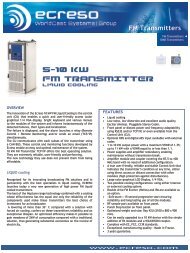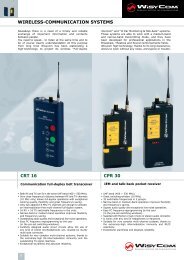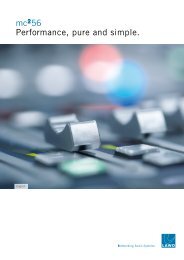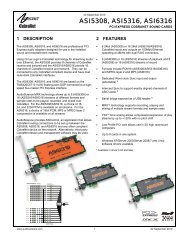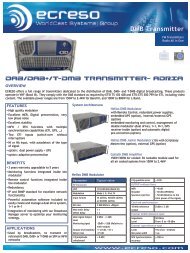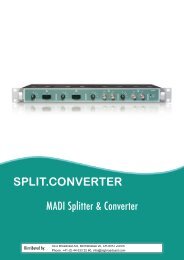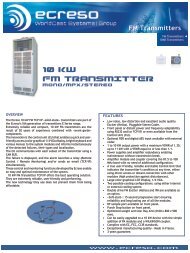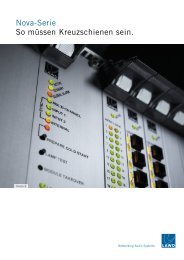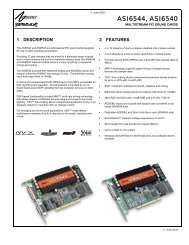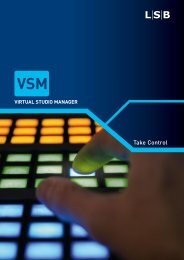Omnia ONE Brochure - Web Quality - Omnia Audio
Omnia ONE Brochure - Web Quality - Omnia Audio
Omnia ONE Brochure - Web Quality - Omnia Audio
Create successful ePaper yourself
Turn your PDF publications into a flip-book with our unique Google optimized e-Paper software.
8 | OMNIA<strong>ONE</strong><br />
<strong>Omnia</strong> <strong>ONE</strong> Performance Specifications (Cont.)<br />
External Sync Range:<br />
h Accepts 32kHz to 96 kHz for synchronization of the Digital<br />
Output signal to an external reference. Automatically accepts<br />
sample rates between 32kHz and 96kHz.<br />
h Connector: EMI-suppressed RJ-45 female pinned according to<br />
StudioHub+® standards, Transformer isolated, balanced, and<br />
floating according to AES3 standard.<br />
Remote Control Methods:<br />
h External Modem or 10/100BaseTX Ethernet.<br />
h--Modem(supportnotyetavailableasof softwareversion2.2): Usersup-<br />
plied Hayes command compatible external serial modem<br />
connected to rear-panel DB-9 male serial port.<br />
h--Ethernet: TCP/IP control via web page interface and Java<br />
(TM) remote control program included in the web pages. All<br />
software is served from the built-in web server; there is nothing<br />
to install on the user’s computer.<br />
h PortsUsed: The defaults are TCP Ports 4545 and 4546 (for control<br />
and metering data, respectively).<br />
FAQ’s<br />
| <strong>Omnia</strong> <strong>ONE</strong> | See <strong>Omnia</strong><strong>Audio</strong>.com/one for more details.<br />
h Connectors: Modem port - EMI-suppressed DB-9 male connector.<br />
Ethernet - Industry standard EMI-suppressed RJ-45 connector.<br />
GPI Interface:<br />
h Support not yet available as of software version 2.2.<br />
h Connector: EMI suppressed DB-9 female connector.<br />
Power Requirements:<br />
h Voltage: 100-250 VAC, 47-63 Hz. Less than 25 VA.<br />
Power Connector:<br />
h EMI suppressed IEC male.<br />
Detachable 3-wire power cords supplied for US and European use.<br />
Power Supply:<br />
h Internal. Overvoltage and short circuit protected. Meets EN55022,<br />
EN55011 Level B Conducted Emissions. EN61000-4-2, -3, -4, -5, -6<br />
level 3 immunity compliant. Full international safety approval. CE<br />
marked.<br />
Environmental:<br />
h Operating Temperature: 32 to 122 deg. F / 0 to 50 deg. C for all<br />
operating voltage ranges. Humidity: 0-95% RH, non-condensing.<br />
I can’t seem to find a remote control software download for the <strong>Omnia</strong><strong>ONE</strong>. Why?<br />
None is needed. Remote control for the <strong>Omnia</strong><strong>ONE</strong> is performed over an Ethernet network connection using any standard web browser that<br />
can run the Java plug-in.<br />
How can I convert my <strong>Omnia</strong><strong>ONE</strong> to a different style?<br />
Similarly to the <strong>Omnia</strong>-3 before it, the <strong>Omnia</strong> One hardware is the same for all styles.<br />
Files are available for free download from the <strong>Omnia</strong> website to convert the <strong>Omnia</strong><strong>ONE</strong> between all of its available styles, currently AM, FM,<br />
Multicast and Studio Pro. These are the same files that are used for software updates.<br />
How much time delay does my <strong>Omnia</strong> <strong>ONE</strong> FM have?<br />
The short answer is “Not enough to drive your DJ’s crazy!” Seriously, we have measured the delay from the input to any output at approximately<br />
8 ms.<br />
Tip: Try both settings of the “Invert” setting in the Input/Output / Input Menu and ask your talent which they prefer. One of the two settings<br />
will put what they are hearing through their headphones more in phase with what they are hearing through their own bone conduction.You<br />
should find that one of the settings sounds better to them and it should be consistent with all of the talent monitoring off-air using the same<br />
feed. This parameter changes the phase of both channels at once, similar to reversing pins 2 & 3 on both channels Input XLR connectors.<br />
After adjusting this setting, most talent gets used to the “new sound” within a few breaks.<br />
Note: If there is additional delay added to the air chain, such as from a Digital STL (especially a codec based STL), the cumulative delay may<br />
become excessive and cause discomfort for the on-air talent. Real-world tests have determined that a slight echo may begin to be heard at<br />
about 15 ms, and anything above 25-30 ms is usually too annoying to talent monitoring off the air.



